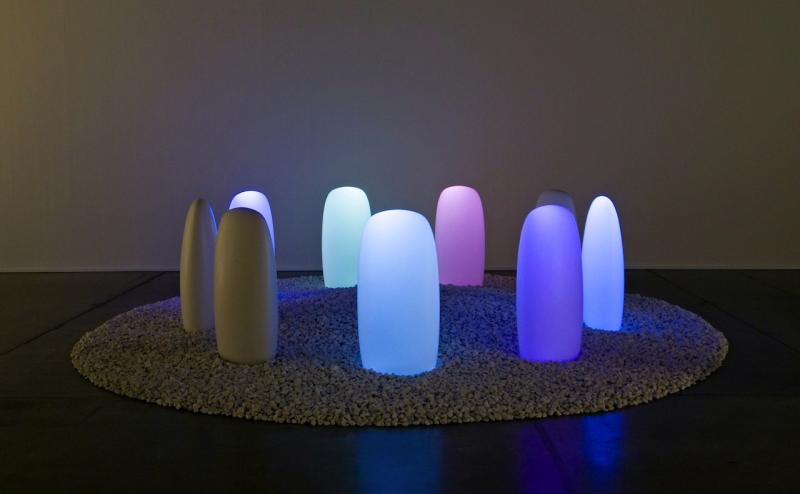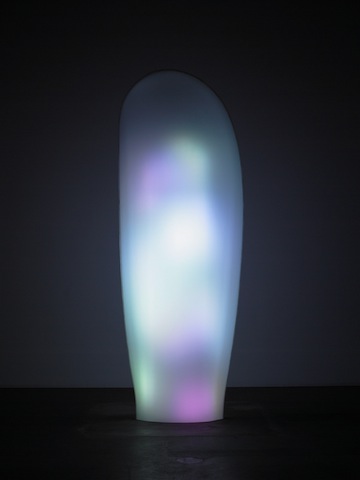Mariko Mori: Rebirth, Burlington Gardens, Royal Academy | reviews, news & interviews
Mariko Mori: Rebirth, Burlington Gardens, Royal Academy
Mariko Mori: Rebirth, Burlington Gardens, Royal Academy
New Age baubles, twee drawings and a light-emitting Stonehenge

The Royal Academy’s spacious white galleries at Burlington Gardens are flooded with mystic light and filled with New Age baubles. You are bathed in a trippy purple haze as you enter one gallery which contains a giant glowing pod. The translucent pod is meant to resemble an ancient monolith but instead looks more like an oversized Ikea lamp. The work derives its title, Tom Na H-iu II, from the Celtic “Tom na h-iubhraich” – a site of “spiritual transmigration”.
The pod installation seems incredibly derivative of James Turrell’s spacey light art, though it’s nowhere near as intense. Turrell creates light installations which physically engulf you: as light changes in intensity and colour you are completely enveloped by its effects. If you can imagine it, it really does feel like you’re having a chemical-free acid trip (picured below: Tom Na H-iu II).
The work is the stuff of hokey crystal-gazing - science mixed with a lot of cosmic mysticism
The LED lights in Mariko Mori’s giant pod are connected to a computer monitoring neutrinos at Tokyo University’s Kamioka Observatory. The pod’s changing light patterns apparently record the presence of these elementary space particles. But whatever the awesome science behind the work, the work itself is the stuff of hokey crystal-gazing - science mixed with a lot of cosmic mysticism, with the exhibition vaguely following the narrative trajectory of the death of a star and the cycles of life, death and rebirth found in Buddhism and Shintoism. Mori is Japanese but has lived most of her adult life in New York, and the cultural mash-up of the ancient and the New Age doesn’t have much subtlety to it.
 Other works include Primal Memory, an arrangement of white stones placed on the floor, though the stones are, in fact, made of translucent glass. The stones arranged in the inner circle emit white light. As an object of spiritual contemplation I’m afraid I find it to be just as naff as any plastic Sacred Heart, though since this is contemporary art and not a religious artefact the only thing that might elevate it as a receptacle of belief is a fervent belief in kitsch contemporary art.
Other works include Primal Memory, an arrangement of white stones placed on the floor, though the stones are, in fact, made of translucent glass. The stones arranged in the inner circle emit white light. As an object of spiritual contemplation I’m afraid I find it to be just as naff as any plastic Sacred Heart, though since this is contemporary art and not a religious artefact the only thing that might elevate it as a receptacle of belief is a fervent belief in kitsch contemporary art.
Then there’s the mini Stonehenge, Transcircle, in which each “stone” is a different pastel colour which glows in the dark. Art channelled as religious experience, or religious experience channelled as art, is nothing new. Rothko wanted above all for his paintings to communicate something elemental and profound – something like a religious experience. If you are merely moved by the colour relationships in his work then you are, in Rothko’s words, “missing the point”.
You may or may not get any of that from actually looking at a Rothko, but at least we are spared light-emitting replicas of Stonehenge. And there are no crystal pendulums hanging above crystal circles. I could go on - about the ectoplasmic photographs and the twee glittery star drawings - but, enough, you get the picture. None of it bodes well for the RA's contemporary art programme.
- Mariko Mori: Rebirth at the Royal Academy’s Burlington Gardens until 17 February
Explore topics
Share this article
Add comment
The future of Arts Journalism
You can stop theartsdesk.com closing!
We urgently need financing to survive. Our fundraising drive has thus far raised £49,000 but we need to reach £100,000 or we will be forced to close. Please contribute here: https://gofund.me/c3f6033d
And if you can forward this information to anyone who might assist, we’d be grateful.

Subscribe to theartsdesk.com
Thank you for continuing to read our work on theartsdesk.com. For unlimited access to every article in its entirety, including our archive of more than 15,000 pieces, we're asking for £5 per month or £40 per year. We feel it's a very good deal, and hope you do too.
To take a subscription now simply click here.
And if you're looking for that extra gift for a friend or family member, why not treat them to a theartsdesk.com gift subscription?
more Visual arts
 'We are bowled over!' Thank you for your messages of love and support
Much-appreciated words of commendation from readers and the cultural community
'We are bowled over!' Thank you for your messages of love and support
Much-appreciated words of commendation from readers and the cultural community
 Lee Miller, Tate Britain review - an extraordinary career that remains an enigma
Fashion photographer, artist or war reporter; will the real Lee Miller please step forward?
Lee Miller, Tate Britain review - an extraordinary career that remains an enigma
Fashion photographer, artist or war reporter; will the real Lee Miller please step forward?
 Kerry James Marshall: The Histories, Royal Academy review - a triumphant celebration of blackness
Room after room of glorious paintings
Kerry James Marshall: The Histories, Royal Academy review - a triumphant celebration of blackness
Room after room of glorious paintings
 Folkestone Triennial 2025 - landscape, seascape, art lovers' escape
Locally rooted festival brings home many but not all global concerns
Folkestone Triennial 2025 - landscape, seascape, art lovers' escape
Locally rooted festival brings home many but not all global concerns
 Sir Brian Clarke (1953-2025) - a personal tribute
Remembering an artist with a gift for the transcendent
Sir Brian Clarke (1953-2025) - a personal tribute
Remembering an artist with a gift for the transcendent
 Emily Kam Kngwarray, Tate Modern review - glimpses of another world
Pictures that are an affirmation of belonging
Emily Kam Kngwarray, Tate Modern review - glimpses of another world
Pictures that are an affirmation of belonging
 Kiefer / Van Gogh, Royal Academy review - a pairing of opposites
Small scale intensity meets large scale melodrama
Kiefer / Van Gogh, Royal Academy review - a pairing of opposites
Small scale intensity meets large scale melodrama
 Jenny Saville: The Anatomy of Painting, National Portrait Gallery review - a protégé losing her way
A brilliant painter in search of a worthwhile subject
Jenny Saville: The Anatomy of Painting, National Portrait Gallery review - a protégé losing her way
A brilliant painter in search of a worthwhile subject
 Abstract Erotic, Courtauld Gallery review - sculpture that is sensuous, funny and subversive
Testing the boundaries of good taste, and winning
Abstract Erotic, Courtauld Gallery review - sculpture that is sensuous, funny and subversive
Testing the boundaries of good taste, and winning
 Edward Burra, Tate Britain review - watercolour made mainstream
Social satire with a nasty bite
Edward Burra, Tate Britain review - watercolour made mainstream
Social satire with a nasty bite
 Ithell Colquhoun, Tate Britain review - revelations of a weird and wonderful world
Emanations from the unconscious
Ithell Colquhoun, Tate Britain review - revelations of a weird and wonderful world
Emanations from the unconscious
 Rachel Jones: Gated Canyons, Dulwich Picture Gallery review - teeth with a real bite
Mouths have never looked so good
Rachel Jones: Gated Canyons, Dulwich Picture Gallery review - teeth with a real bite
Mouths have never looked so good

Comments
Thank you. The two
Thanks, have corrected that.
Thanks, have corrected that.